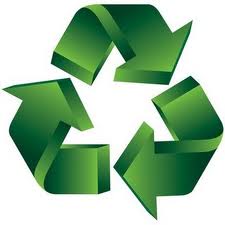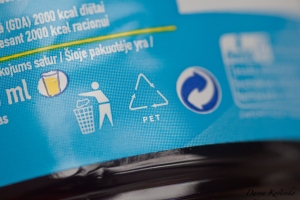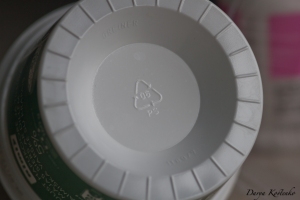- According to Eurostat data (2011), every inhabitant of Latvia generates ~6 kg of waste a week, ~28 kg a month and ~333 kg a year. Thus every year Latvia generates 600-700 000 tons of household waste.
- Approximately 20-30% of the volume of household waste accounts for waste packaging. The percentage is directly liked to the prosperity of people – urban population and wealthy households use a larger amount of packaged goods.
- The total per capita consumption in Latvia is ~58 kg of which 35% is glass, 32% paper and cardboard, 22% various polymers (plastic bottles, plastic packaging of household chemicals), 5% is wood packaging, 3% metal (cans) and 3% is other types of packaging.
- PET bottles form ~3% of the total amount of household waste.
- Most of the waste packaging collected in Latvia is also recycled here. PET bottles are recycled into high-quality PET flakes by the factory PET Baltija in Jelgava, the factory Nordic Plast in Olaine recycles plastic films and packaging bags by melting and granulating them, while waste paper, cardboard and cardboard juice and milk packaging is used to make a range of paper products by Līgatnes papīrfabrika. The glass collected in Latvia is mainly processed in Lithuania and Ukraine.
- In order to reach environmental management targets set in the EU directive on packaging and packaging waste, Latvia has to ensure processing 50-65 % of the total weight of packaging waste. Latvia is far from this goal. In recent two years the volume of processed materials has not essentially increased and landfill sites are increasingly loaded. The new production plant will ease on its part the situation. It has the capacity for processing 40 000 tons more waste materials per year, tells Reinis Ceplis, L&T Area Director in Latvia.
- The environmental education programme „Green Dot School” has been running for 10 years. More than 1/3 of all comprehensive schools and preschools in Latvia have participated in its projects. Every year more new participants are joining the „Green Dot School” projects.
RecycleRiga
find out where and how to recycle in Riga
Where to recycle?
Where can you take your recyclables? There are two maps from two websites that I have been using. I find atkritumi.lv very informative and most of the times the bins are actually there where they mention them. On the left hand side of that website you select the type of waste you are interested in and than select the district of the city you live in.
Atkritumi.lv – visi kopā tīrai Latvijai.
This map from L&T company is pretty good and you don’t have to select each of the type separately they show you straight away on the map which bin are where.
Also if you are outside of Riga or there aren’t any bins near by and you live in a private house, you can order them through L&T company. Obviously, you would have to pay a fee depending on the amounts of waste that is required to be collected.
How to recycle?
Here you have to believe me and try it yourself at least for one month and you will see that what seemed a burden is actually quiet easily becomes a healthy habit.
Start by doing what’s easy and simple. You don’t have to be an expert over night. The first step is to start realising that there is ‘no such place as away’ so when you ‘throw something away’ it just goes some place else, for someone else to deal with or most likely becomes a contamination in the environment.
Why recycle?
Why should I recycle?
Because if you throw something away, it is no longer useful, it ends up in landfill, incinerated, or in some other way contaminating the environment. If you recycle something, it can be recovered and become material for a new product, plus it does not go to into the waste stream.
Why is it important to recycle?
Because there is a real global problem with too much waste being produced by human beings. As a species we produce so much synthetic waste that we are literally running out of space to bury it, or dispose of it in other ways without contaminating the environment.
Is it really worth recycling?
Absolutely. There is also a benefit to business and industry. The cost of recovering raw materials from existing waste items is far less than the original manufacturing process costs. There is a benefit to the environment. Using recycled materials reduces the destructive extraction processes and energy required to obtain raw materials.
Does all this really affect home waste?
Yes, between 60% and 75% of all home synthetic waste can be usefully recycled, providing all the benefits as detailed above. The more people that engage in home recycling the more resources are available for reusing these materials for new manufacturing, plus lessening the load on waste disposal.
Isn’t this just scare mongering?
No, it’s a genuine concern amongst scientists that waste contamination and its bi-products contributes to global warming, climate change that affect wildlife and crops. Plus it produces dangerous imbalances in natural eco-systems.
Why should I do something now about recycling?
Because the biggest most powerful changes lie in the habits and attitudes of ordinary people. Becoming environmentally aware and responsible is no longer an option for the few. If we want to save our world from an environmental catastrophe we must all act now and together. This is the only way to send a clear message to politicians and decision makers that we need change.
Here are some interesting facts, that I hope will inspire you to add this easy habit to your lifestyle:
What is recycling?
Recycling is processing used materials (waste) into new products to prevent waste of potentially useful materials, reduce the consumption of fresh raw materials, reduce energy usage, reduce air pollution (from incineration) and water pollution (from landfilling) by reducing the need for “conventional” waste disposal, and lower greenhouse gas emissions as compared to virgin production.
Recyclable materials include many kinds of glass, paper, metal, plastic, textiles, and electronics. Materials to be recycled are either brought to a collection center or picked up from the curbside, then sorted, cleaned, and reprocessed into new materials bound for manufacturing. In Riga mostly curbside collection takes place.
Curbside collection encompasses many subtly different systems, which differ mostly on where in the process the recyclates are sorted and cleaned. The main categories are mixed waste collection, commingled recyclables and source separation. A waste collection vehicle generally picks up the waste.
In order to meet recyclers’ needs while providing manufacturers a consistent, uniform system, a coding system is developed.
Normally city council should provide a booklet or information on which recycling codes are acceptable in local recycling plant. According to L&T website Latvia only recycles PET and PE plastics, which are number 1 and 2 recycling codes for plastics.
For paper you can generally recycle all paper products except for those containing plastic or foil elements or glassy journal covers.
As for glass there is a well known phenomenon and a perfect example how recycling is encourage through financial reward. Beer bottles and the like have been a way to get some pocket money for myself too, when I was a kid. Now sadly to admit it is one of the means of income for homeless people. So if you don’t find a recycling bin nearby after finishing one of the delicious beers in Riga, just leave it on the curb, soon it will be picked up and delivered to one of the recycling points where agents get their reward for it. Other than that most of all glass products are recycle except for lightbulbs, car window glass and broken plates.
Here you can find all recycling codes description.




